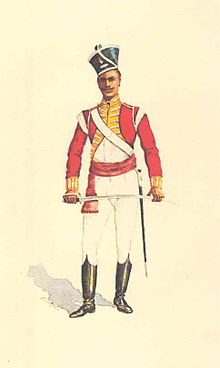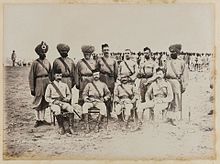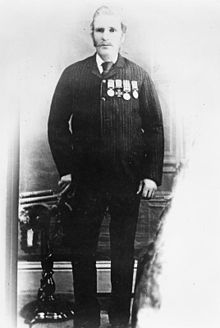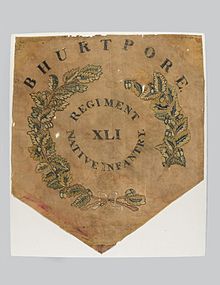Bengal Native Infantry
| Bengal Native Infantry | |
|---|---|
 Flag of the British East India Company | |
| Active | 1757–1858 (as part of the East India Company's Bengal Army) 1858–1895 (as part of the Bengal Army of the British Raj) 1895–1903 (under the Bengal command of the British Indian Army) |
| Allegiance | East India Company United Kingdom |
| Branch | Bengal Army |
| Role | Infantry |
| Size | 19 Battalions (1764)[1] 74 Regiments (1857)[2] 45 Regiments (1861)[3] |
| Conflicts | Battle of Plassey Third Carnatic War First Anglo-Mysore War Second Anglo-Mysore War Third Anglo-Mysore War First Anglo-Maratha War Cotiote War Fourth Anglo-Mysore War Second Anglo-Maratha War Invasion of Java Anglo-Nepalese War Third Anglo-Maratha War First Anglo-Burmese War First Opium War First Anglo-Afghan War First Anglo-Sikh War Second Anglo-Sikh War Second Anglo-Burmese War Indian Mutiny Second Opium War Second Anglo-Afghan War Suakin Expedition Third Anglo-Burmese War |
The regiments of Bengal Native Infantry, alongside the regiments of Bengal European Infantry, were the regular infantry components of the East India Company's Bengal Army from the raising of the first Native battalion in 1757 to the passing into law of the Government of India Act 1858 (as a direct result of the Indian Mutiny). At this latter point control of the East India Company's Bengal Presidency passed to the British Government. The first locally recruited battalion was raised by the East India Company in 1757 and by the start of 1857 there were 74 regiments of Bengal Native Infantry in the Bengal Army. Following the Mutiny the Presidency armies came under the direct control of the United Kingdom Government and there was a widespread reorganisation of the Bengal Army that saw the Bengal Native Infantry regiments reduced to 45.
The title "Bengal Native Infantry" fell out of use in 1885 and the Bengal Infantry regiments ceased to exist when the three separate Presidency armies were absorbed into the British Indian Army in 1903. There are units currently serving in the armies of India, Pakistan and the United Kingdom who can trace their lineage directly to units of the Bengal Native Infantry, for example the Jat Regiment in the Indian Army, the Royal Gurkha Rifles in the British Army and 6th Battalion, The Punjab Regiment in the Army of Pakistan.
Numbering of regiments, unit designations and nomenclature
[edit]

The first locally recruited unit of the East India Company's forces in Bengal, raised in 1757 and present at the Battle of Plassey, was known as the Galliez Battalion (named after one of its first Captains) and called the Lal Pultan (Red Battalion) by its locally recruited members.[4][5] The Bengal Native Infantry regiments underwent frequent changes of numbering during their existence, with the numbers assigned following a reorganisation bearing little or no connection to the regiments that held the pre-existing numbers. The traditional formation of British and Presidency armies' regiments was by a hierarchy in which the "1st Regiment" was the oldest and the highest number was given to the youngest. In 1764 however, the Bengal Native Infantry regiments were renumbered in the order of the individual seniority of their commanding officers.[5] The regiments were reorganised and renumbered (or renamed) twice in 1861, in 1864, again in 1885 and finally in 1903 the Bengal Army was absorbed into the British Indian Army and the Bengal Infantry ceased to exist.[3][6]
The inclusion of the word "Native" in the titles of the Bengal Native Infantry regiments and throughout the Bengal, Bombay and Madras Armies indicated that the troops were locally recruited in India (or neighbouring areas), in contrast with the Bengal European Infantry which recruited personnel in the United Kingdom. In 1885, the word "Native" was dropped from the titles of all military units in the Bengal Army.[3]
Recruitment and demographics
[edit]The 1st Brahmans was the first infantry regiment of the British Indian Army. It was raised at Oudh by Captain T Naylor in 1776

The Bengal army mostly recruited upper-caste elements like Kanyakubja Brahmins, Rajputs, from Awadh.[7][8]
Bengal Native Infantry regiments typically consisted of 800 privates (sepoys), 120 non-commissioned officers (havildars and naiks), 20 native commissioned officers (subedars and jemadars), 2 British sergeants and 26 British commissioned officers.[9] Regiments were commanded by a lieutenant-colonel and were divided into 10 companies, each assigned 2 British officers and 2 native officers. Each regiment was assigned an adjutant, an interpreter and a quartermaster.[10] The majority of recruits for the Bengal Native Infantry in the years leading up to the Mutiny were from the districts of Bengal, Oudh (Awadh) and the surrounding areas – around three quarters of the total numbers.[11]
Mutinying regiments officially ceased to exist following the Mutiny and in 1861 the twelve surviving Bengal Native Infantry regiments (units that did not mutiny, units that were disarmed and later considered to be free of mutineers or units that were disbanded peacefully & were later reformed) were joined by a mix of hastily raised units (for example, the Allahabad Levy became the 33rd Bengal Native Infantry[12]) or newly created units from the Punjab (for example, the 7th Regiment of Punjab Infantry became the 19th Bengal Native Infantry). In addition, soldiers who did not mutiny when the rest of their regiment did so joined units such as The Lucknow Regiment or The Loyal Purbiah Regiment.[2]
Pre-1857 list of Bengal Native Infantry Regiments
[edit]The Mutiny and its aftermath
[edit]

During the Indian Mutiny all but twelve of the seventy-four regular Bengal Native Infantry regiments either mutinied, were disarmed, or disbanded peacefully and returned to their homes. Those that mutinied engaged in armed conflict with their officers, other East India Company forces or British Army units. The men of the Bengal Native Infantry were professional soldiers and "Mutiny" was a specific criminal offence under the Articles of War and the Mutiny Acts, carrying the death penalty following a conviction after trial by court-martial. The executions were carried out either by hanging, by firing squad or by blowing from a gun.[14] Mutinying regiments officially ceased to exist and their place in the Order of precedence of the Bengal Army was taken by another unit.[3]
Those BNI units that were disbanded without violence, were disarmed either by their officers, other East India Company forces or by British Army units using threat of force and then either remained under discipline but weaponless in their cantonments or were allowed to disperse. For example, the 33rd and 35th regiments of Bengal Native Infantry were disarmed at Phillour on the morning of 25 June 1857 by the 52nd (Oxfordshire) Regiment of Foot (around 800 men) under the command of Brigadier General John Nicholson with the support of the 17th Light Field Battery, Bengal Horse Artillery (12 guns). The 33rd and 35th BNI, around 1500 men, were part of the Punjab Moveable Column, a brigade that was formed to quash outbreaks of mutiny in the Punjab and that was eventually ordered to Delhi to join the Delhi Field Force. Brigadier General Nicholson was doubtful of their loyalty and was therefore unwilling to take these regiments to Delhi. As the Moveable Column made its way to Phillour the 52nd Regiment of Foot and the artillery were ordered to press on ahead, arriving at the camping ground before the other regiments. When the 35th BNI arrived at the camping ground they found themselves surrounded on three sides by the 52nd Regiment of Foot and covered by the guns of the artillery. Brigadier General Nicholson then informed Colonel Younghusband, the commanding officer, that his men "must give up their arms!" – this order was complied with peacefully. The scene was repeated a short time later when the 33rd BNI arrived at the camping ground.[13][15]
Sepoys from those regiments that were disbanded peacefully, generally returned to their homes, including the 34th Regiment of Bengal Native Infantry which was disbanded on 6 May 1857 at Barrackpore following the actions of Mangal Pandey and his execution for mutiny shortly before the main outbreak.[10] Two regiments of BNI (the 65th and 70th) were serving in China at the time of the outbreak and remained unaffected by the disturbances in Bengal.[16]
During the Mutiny the United Kingdom Government passed the Government of India Act 1858 which established the British Raj, bringing to an end Company rule in India by stripping the East India Company of all its administrative powers and handing over control of its Indian territories and armed forces to the British Crown.[17] Section 56 of the Government of India Act stated:
"LVI. The military and naval forces of the East India Company shall be deemed to be the Indian military and naval forces of Her Majesty, and shall be under the same obligations to serve Her Majesty as they would have been under to serve the said Company, and shall be liable to serve within the same territorial limits only, for the same terms only, and be entitled to the like pay, pensions, allowances, and privileges, and the like advantages as regards promotion and otherwise, as if they had continued in the service of the said Company: such forces, and all persons hereafter enlisting in or entering the same, shall continue and be subject to all Acts of Parliament, laws of the Governor-General of India in Council, and articles of war, and all other laws, regulations, and provisions relating to the East India Company's military and naval forces respectively, as if Her Majesty's Indian military and naval forces respectively had throughout such acts, laws, articles, regulations; and provisions been mentioned or referred to, instead of such forces of the said Company; and the pay and expenses of and incident to Her Majesty's Indian military and naval forces shall be defrayed out of the revenues of India."[18]
The twelve "old regiments" that did not mutiny, continued to serve after the Mutiny and were allowed to retain traditions such as red uniforms.[19] and existing battle honours. Following the completion of a widespread reform of the army in what was now the British Raj, the Bengal Native Infantry was reduced in size and renumbered in 1861. The "loyal" regiments took the first places in the order of precedence, starting with the 21st Regiment of BNI becoming the 1st BNI. There was then a second renumbering of the regiments the same year as a result of transferring four regiments to the Goorkha list. The post-1861 Bengal Native Infantry therefore consisted of 45 regiments.[2]
Post-1861 list of Bengal Native Infantry Regiments
[edit]| First 1861 title.[3] | Second 1861 title.[3] | Previous title.[3] |
|---|---|---|
| 1st Regiment of Bengal Native Infantry | Unchanged | 21st Regiment of Bengal Native Infantry |
| 2nd Regiment of Bengal Native (Light) Infantry | Unchanged | 31st Regiment of Bengal Native (Light) Infantry |
| 3rd Regiment of Bengal Native Infantry | Unchanged | 32nd Regiment of Bengal Native Infantry |
| 4th Bengal Regiment of Bengal Native Infantry | Unchanged | 33rd Regiment of Bengal Native Infantry |
| 5th Regiment of Bengal Native (Light) Infantry | Unchanged | 42nd Regiment of Bengal Native (Light) Infantry |
| 6th Regiment of Bengal Native (Light) Infantry | Unchanged | 43rd Regiment of Bengal Native (Light) Infantry |
| 7th Regiment of Bengal Native Infantry | Unchanged | 47th Regiment of Bengal Native Infantry (Volunteers) |
| 8th Regiment of Bengal Native Infantry | Unchanged | 59th Regiment of Bengal Native Infantry |
| 9th Regiment of Bengal Native Infantry | Unchanged | 63rd Regiment of Bengal Native Infantry |
| 10th Regiment of Bengal Native Infantry | Unchanged | 65th Regiment of Bengal Native Infantry (Volunteers) |
| 11th Regiment of Bengal Native Infantry | 1st Goorkha Regiment | 66th (Goorkha) Regiment of Bengal Native Infantry |
| 12th Regiment of Bengal Native Infantry | 11th Regiment of Bengal Native Infantry | 70th Regiment of Bengal Native Infantry |
| 13th Regiment of Bengal Native Infantry | 12th Regiment of Bengal Native Infantry | The Regiment of Kelat-i-Ghilzie |
| 14th Regiment of Bengal Native Infantry | 13th Regiment of Bengal Native Infantry | The Shakhawati Battalion |
| 15th Regiment of Bengal Native Infantry | 14th Regiment of Bengal Native Infantry | The Regiment of Ferozepore |
| 16th Regiment of Bengal Native Infantry | 15th Regiment of Bengal Native Infantry | The Regiment of Ludhiana |
| 17th Regiment of Bengal Native Infantry | 2nd Goorkha Regiment | The Sirmoor Rifle Regiment |
| 18th Regiment of Bengal Native Infantry | 3rd Goorkha Regiment | The Kumaon Battalion |
| 19th Regiment of Bengal Native Infantry | 4th Goorkha Regiment | The Extra Goorkha Battalion |
| 20th Regiment of Bengal Native Infantry | 16th Regiment of Bengal Native Infantry | The Lucknow Regiment |
| 21st Regiment of Bengal Native Infantry | 17th Regiment of Bengal Native Infantry | The Loyal Purbeah Regiment |
| 22nd Regiment of Bengal Native Infantry | 18th Regiment of Bengal Native Infantry | The Alipore Regiment |
| 23rd Regiment of Bengal Native Infantry | 19th Regiment of Bengal Native Infantry | 7th Punjab Regiment |
| 24th Regiment of Bengal Native Infantry | 20th Regiment of Bengal Native Infantry | 8th Punjab Regiment |
| 25th Regiment of Bengal Native Infantry | 21st Regiment of Bengal Native Infantry | 9th Punjab Regiment |
| 26th Regiment of Bengal Native Infantry | 22nd Regiment of Bengal Native Infantry | 11th Punjab Regiment |
| 27th Regiment of Bengal Native Infantry | 23rd Regiment of Bengal Native Infantry | 15th Punjab Regiment |
| 28th Regiment of Bengal Native Infantry | 24th Regiment of Bengal Native Infantry | 16th Punjab Regiment |
| 29th Regiment of Bengal Native Infantry | 25th Regiment of Bengal Native Infantry | 17th Punjab Regiment |
| 30th Regiment of Bengal Native Infantry | 26th Regiment of Bengal Native Infantry | 18th Punjab Regiment |
| 31st Regiment of Bengal Native Infantry | 27th Regiment of Bengal Native Infantry | 19th Punjab Regiment |
| 32nd Regiment of Bengal Native Infantry | 28th Regiment of Bengal Native Infantry | 20th Punjab Regiment |
| 33rd Regiment of Bengal Native Infantry | 29th Regiment of Bengal Native Infantry | 21st Punjab Regiment |
| 34th Regiment of Bengal Native Infantry | 30th Regiment of Bengal Native Infantry | 22nd Punjab Regiment |
| 35th Regiment of Bengal Native Infantry | 31st Regiment of Bengal Native Infantry | 23rd Punjab Regiment |
| 36th Regiment of Bengal Native Infantry | 32nd Regiment of Bengal Native Infantry | 24th Punjab Regiment |
| 37th Regiment of Bengal Native Infantry | 33rd Regiment of Bengal Native Infantry | The Allahabad Levy |
| 38th Regiment of Bengal Native Infantry | 34th Regiment of Bengal Native Infantry | The Fatehgarh Levy |
| 39th Regiment of Bengal Native Infantry | 35th Regiment of Bengal Native Infantry | The Mynpoorie Levy |
| 40th Regiment of Bengal Native Infantry | 36th Regiment of Bengal Native Infantry | The Bareilly Levy |
| 41st Regiment of Bengal Native Infantry | 37th Regiment of Bengal Native Infantry | The Meerut Levy |
| 42nd Regiment of Bengal Native Infantry | 38th Regiment of Bengal Native Infantry | The Agra Levy |
| 43rd Regiment of Bengal Native Infantry | 39th Regiment of Bengal Native Infantry | The Aligarh Levy |
| 44th Regiment of Bengal Native Infantry | 40th Regiment of Bengal Native Infantry | The Shajehanpur Levy |
| 45th Regiment of Bengal Native Infantry | 41st Regiment of Bengal Native Infantry | 1st Gwalior Regiment |
| 46th Regiment of Bengal Native Infantry | 42nd Regiment of Bengal Native Infantry | 1st Assam Light Infantry |
| 47th Regiment of Bengal Native Infantry | 43rd Regiment of Bengal Native Infantry | 2nd Assam Light Infantry |
| 48th Regiment of Bengal Native Infantry | 44th Regiment of Bengal Native Infantry | The Sylhet Light Infantry |
| 49th Regiment of Bengal Native Infantry | 45th Regiment of Bengal Native Infantry | 1st Bengal Military Police Battalion |
Operational history and legacy
[edit]

Operational history
[edit]The Bengal Native Infantry has participated in major battles and wars that include, among others, the following engagements:[20][21]
- Battle of Plassey
- Third Carnatic War
- First Anglo-Mysore War
- Second Anglo-Mysore War
- Third Anglo-Mysore War
- First Anglo-Maratha War
- Cotiote War
- Fourth Anglo-Mysore War
- Second Anglo-Maratha War
- Invasion of Java
- Anglo-Nepalese War
- Third Anglo-Maratha War
- First Anglo-Burmese War
- First Opium War
- First Anglo-Afghan War
- First Anglo-Sikh War
- Second Anglo-Sikh War
- Second Anglo-Burmese War
- Indian Mutiny
- Second Opium War
- Second Anglo-Afghan War
- Suakin Expedition
- Third Anglo-Burmese War
Legacy
[edit]
The Bengal Army was absorbed into the British Indian Army in 1903 with a large number of infantry units passing into the newly organised force.[6] As shown by the following examples, there are a number of military units active today that can trace their lineage directly to regiments of Bengal Native Infantry in the armies of India, Pakistan and the United Kingdom. In many cases these units maintain the traditions and retain the battle honours of their antecedent regiments.
India
[edit]- The Jat Regiment traces its lineage back to 1795, to an East India Company unit known as the Calcutta Native Militia which, after a series of name changes, became the 18th regiment of Bengal Native Infantry in 1861. The Jat Regiment also traces its lineage to the pre-1857 43rd and 65th regiments of Bengal Native Infantry. The regiment retains the battle honours of its antecedent units.[22]
- The Sikh Regiment traces its lineage back to the post-1861 14th, 15th and 45th regiments of Bengal Native Infantry (among other units). The regiment retains the battle honours and some traditions of its antecedent units.[23]
Pakistan
[edit]- 6th Battalion, The Punjab Regiment directly traces its lineage to the post-1861 20th regiment of Bengal Native Infantry. The Punjab Regiment does not retain any battle honours gained before Pakistan's independence.[24]
United Kingdom
[edit]- The Royal Gurkha Rifles traces its lineage to the post-1861 42nd and 43rd regiments of Bengal Native Infantry (among other units). The Royal Gurkha Rifles retains the battle honours and traditions of its antecedent units.[25]
See also
[edit]References
[edit]- Citations
- ^ Williams, John (1817). An historical account of the rise and progress of the Bengal Native Infantry, from its first formation in 1757, to 1796 when the present regulations took place, together with a detail of the services on which the several battalions have been employed. London: John Murray.
- ^ a b c d e Quarterly Army List of Her Majesty's British Forces on the Bengal Establishment. Calcutta: R C Lepage & Co. 1859.
- ^ a b c d e f g h Army Headquarters India (1919). Indian Army List (2012 reprinted ed.). Luton: Andrews UK. ISBN 978-1-78150-255-6.
- ^ Raugh, Harold (2004). The Victorians at War, 1815–1914: An Encyclopaedia of British Military History. Santa Barbara, California: ABC-CLIO Inc. p. 45.
- ^ a b Minutes of Evidence Taken Before the Select Committee on the Affairs of the East India Company. London: House of Commons Select Committee on the East India Company. 1832. pp. 333, 334.
- ^ a b Beckett, Ian; Chandler, David (2002). The Oxford History of the British Army (New ed.). Oxford: Oxford University Press. ISBN 0192803115.
- ^ Shrinivas, Mysore Narasimhachar (1973). Social change in modern India. University of California press. p. 71.
- ^ Chattopadhyay, Kunal (20 April 2009). "India, Great Rebellion of 1857 (the Sepoy Revolt)". The International Encyclopedia of Revolution and Protest: 1–9. doi:10.1002/9781405198073.wbierp0743. ISBN 9781405198073.
- ^ Wagner, Kim A. (2018). The Skull of Alum Beg. The Life and Death of a Rebel of 1857. Oxford University Press. p. 14. ISBN 978-0-19-087023-2.
- ^ a b Malleson, G (1858). The Mutiny of the Bengal Army: An Historical Narrative by One Who has Served Under Sir Charles Napier. London: Bosworth & Harrison.
- ^ Mukherjee, Rudrangshu (2001). Awadh in Revolt, 1857–1858: A Study of Popular Resistance. Delhi: Permanent Black. p. 77.
- ^ Rizvi, Brig SHA. (1984). Veteran Campaigners – A History of the Punjab Regiment 1759–1981. Lahore: Wajidalis.
- ^ a b c Cave-Browne, John (1861). The Punjab and Delhi in 1857: Being a Narrative of the Measures by which the Punjab was saved and Delhi recovered during the Indian Mutiny – Volume I & II. London: William Blackwood and Sons. p. 300.
- ^ Indian News (1858), p. 125 Archived 1 July 2023 at the Wayback Machine
- ^ Bourchier, George (1858). Eight Months' Campaign against the Bengal Sepoy Army during the Mutiny of 1857 by Colonel George Bourchier C.B., Bengal Horse Artillery, late commanding No. 17 Light Field Battery. London: Smith, Elder & Co. p. 10.
- ^ MacMunn, Lt. Gen. Sir George (1984). The Armies of India. Crécy. p. 100. ISBN 0-947554-02-5.
- ^ UK Parliament. "East India Company and Raj 1785–1858". UK Parliament. Archived from the original on 9 June 2016. Retrieved 21 June 2016.
- ^ Fieldhouse, David (1985). Select Documents on the Constitutional History of the British Empire and Commonwealth: The Foundations of a Colonial System of Government. Westport, Conn.: Greenwood Press. p. 71. ISBN 0-313-23897-9.
- ^ W.Y. Carman, pp. 107–108, "Indian Army Uniforms Under the British From the 18th century to 1947: Artillery, Engineers and Infantry", Morgan-Grampian: London 1969
- ^ Singh, Sarbans (1993). Battle Honours of the Indian Army 1757 – 1971. New Delhi: Vision Books. ISBN 81-7094-115-6.
- ^ Norman, C. B. (1911). Battle honours of the British Army: From Tangier, 1662, to the Commencement of the Reign of King Edward VII. London: John Murray.
- ^ "Official Website of Indian Army – The Jat Regiment". www.indianarmy.nic.in. Archived from the original on 12 October 2016. Retrieved 13 June 2016.
- ^ "Official Website of Indian Army – The Sikh Regiment". www.indianarmy.nic.in. Archived from the original on 12 October 2016. Retrieved 13 June 2016.
- ^ "The Punjab Regiment". www.pakistanarmy.gov.pk. Archived from the original on 27 September 2016. Retrieved 13 June 2016.
- ^ "Battle Honours". www.rgrra.com. Archived from the original on 18 June 2016. Retrieved 13 June 2016.
